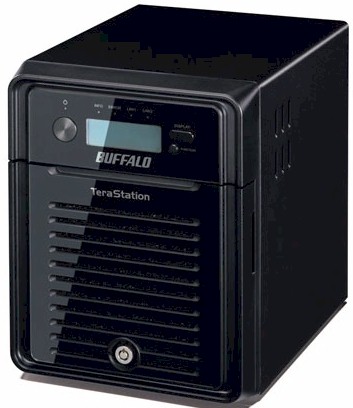
| At a glance | |
|---|---|
| Product | Buffalo Technology TeraStation 3400 (TS3400D0404) [Website] |
| Summary | Four-drive dual-core Marvell Armada XP based business NAS running revamped Buffalo Linux-based OS |
| Pros | • Dual Gigabit Ethernet ports with Failover • Good Value • 2 X USB 3.0 and 2 X USB 2.0 ports |
| Cons | • Doesn’t support rsync to non-Buffalo products • No add-in support • Relatively low USB attached backup performance |
Typical Price: $0 Buy From Amazon
Introduction
Since Buffalo America’s (formerly Buffalo Technology) announcements of the new TeraStation 5000 and 3000 series of NAS devices, we have been busy evaluating the latest offerings. Tim reviewed the TeraStation TS5800, an eight bay NAS that sits at the top of the 5000 series product line. More recently, Scott took a look at the TS5200, the entry level two drive member of the 5000 series. This review will focus on the TeraStation TS3400 – a four drive ARM-based NAS.
Unlike the 5000 series that has five members of its product line, the 3000 series has just two: The TS 3400 and the TS3400r Rackmount. Both of the 3400’s have the same specifications – the difference is the form factor. Both TS3400 models are available in 4 TB, 8 TB, 12 TB and 16 TB configurations.
The family chart below gives you a good idea of where the TS3400 fits in. While you’ll note that all of the feature checkmarks for 5000 and 7000 series of TeraStations are also checked in the TS3000 column, the major differences are in the processor, amount of memory, and number of drive bays.
The 7000 series uses Intel Xeon processors; the 5000 series uses Intel Dual core Atom processors; the 3000 series uses less powerful dual core ARM processors. As you would expect, as you move up through the product lines, the memory increases. The TS3400 has 1 GB of DDR3 memory.
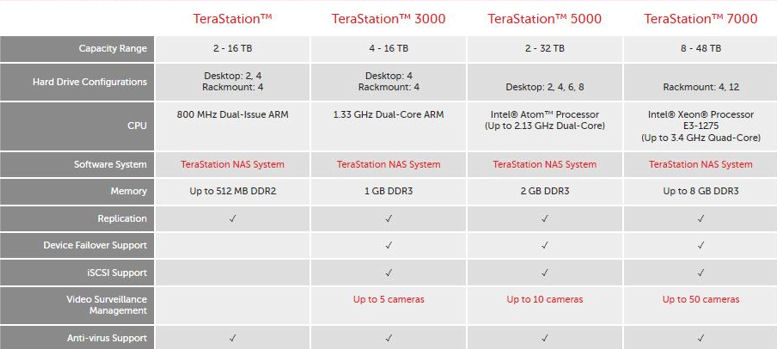
Buffalo TeraStation Series Comparison
As with the 5000 series, the TS3400 has a lockable drive bay door. #12 in the callout chart below is a VGA port for console access. An LCD panel and LEDs provide a useful status information.
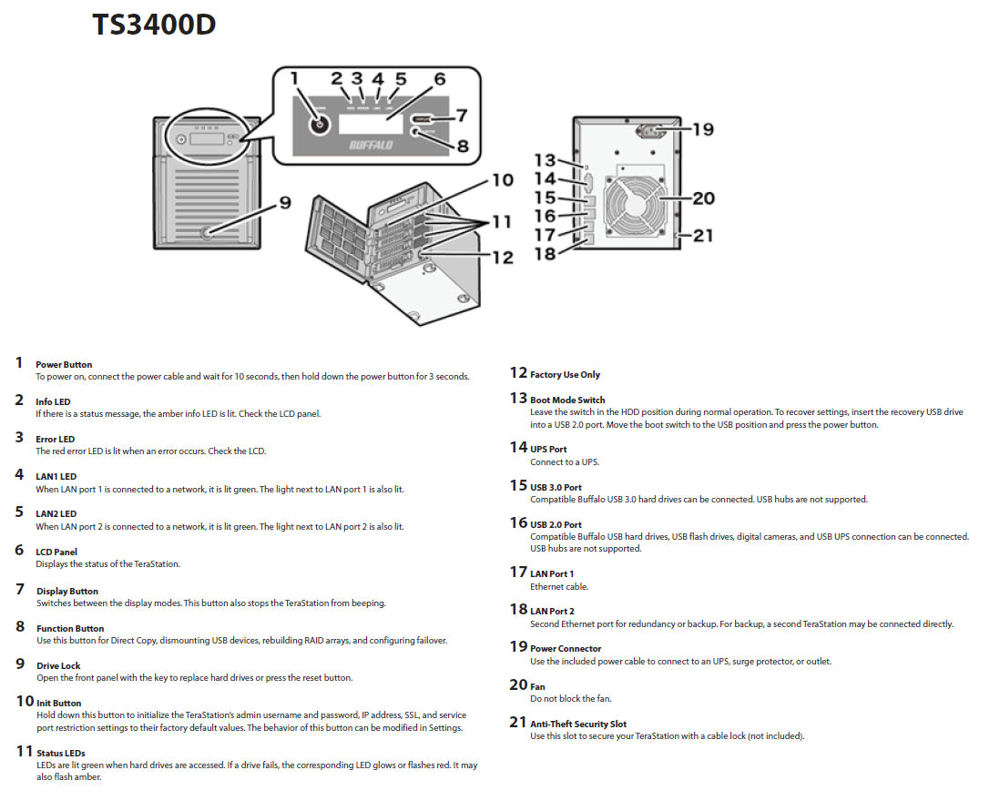
Buffalo TeraStation 3400 callouts
Inside
If you check back on the reviews of the TS5200 and the TS5800, you’ll note that there is a lot of similarity when it comes to case design and PCB layout. The image below shows an internal view of the TS3400. The PCB is mounted vertically along the right side (looking at it from the front) of the NAS. The power supply sits on top of the drive cage. The fan is removable without opening the case. Board replacement is easy, but you’ll need to remove the cover and the rear panel.
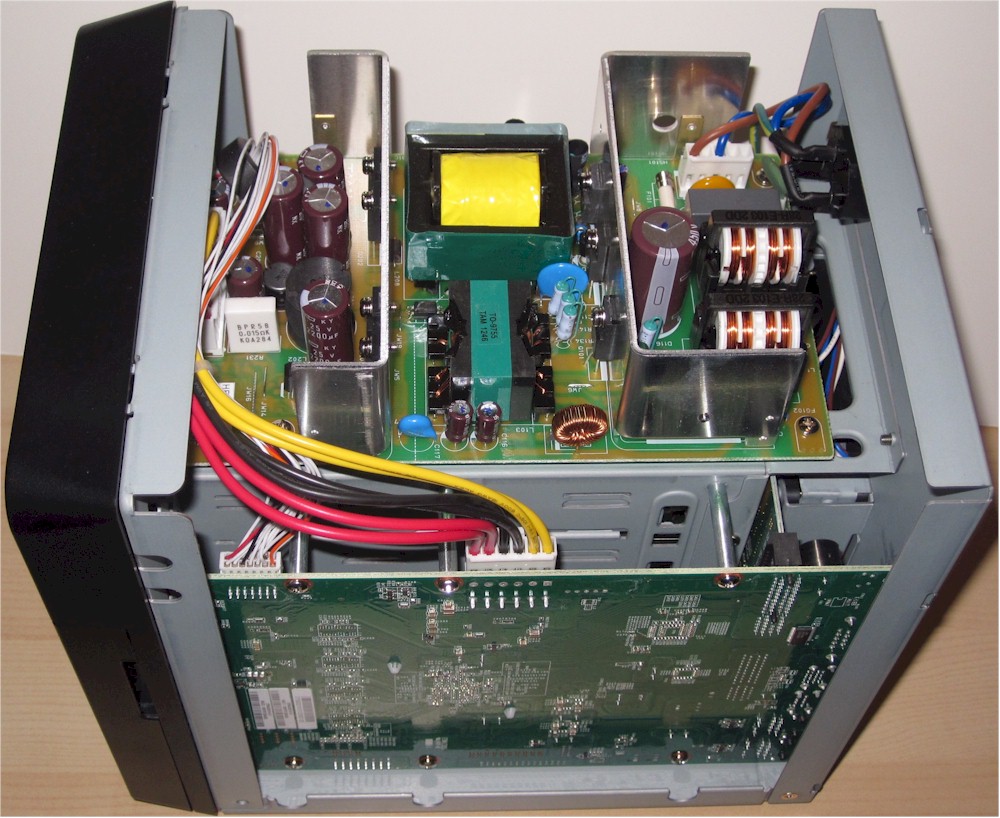
Buffalo TeraStation 3400 inside top view
The board plugs into the drive backplane. You can note the drive backplane connection in the lower right hand corner of the photo above. The TS3400’s board resembles other boards in the TeraStation product line. It’s not too surprising, as the rear panel layout, the positioning of the drive bay and the positioning of the power supply is similar on many of the models.
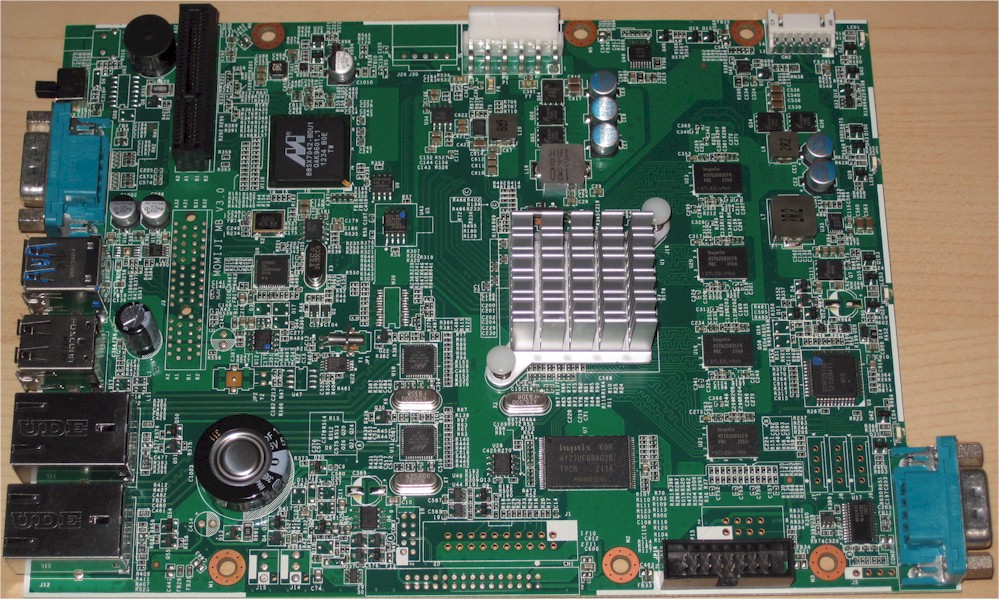
Buffalo TeraStation TS3400 board
For comparison, here’s what the board looked like in the Buffalo Pro Quad. Note that all of the jacks and connectors, including the drive backplane connector are located in similar relative positions. Of course, the components on the PCB are quite different.
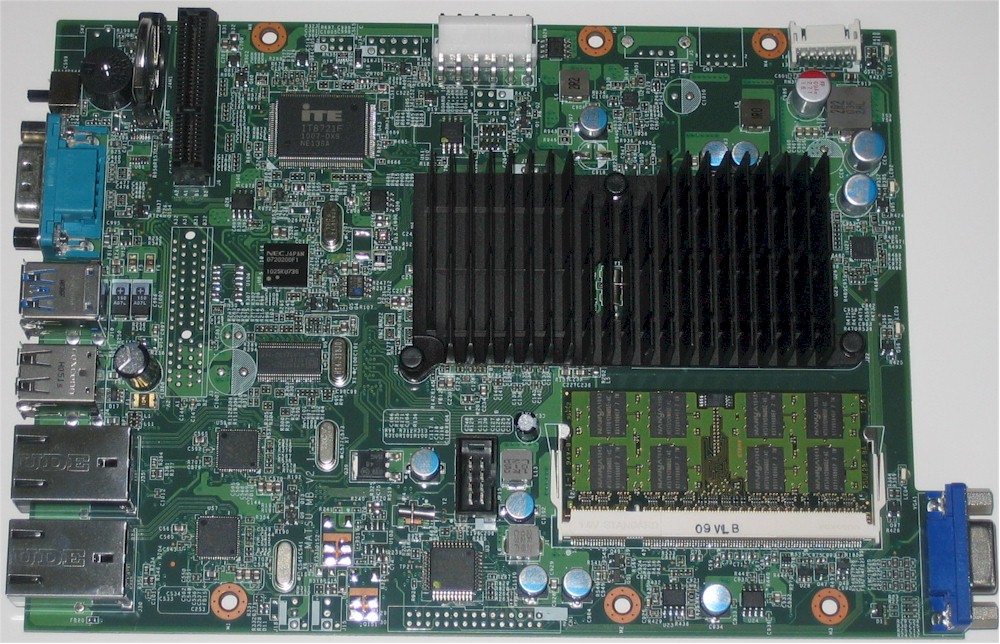
Buffalo TeraStation Pro Quad board
The table below summarizes the key components of the TS3400. Corresponding components for the TS5200 are shown for comparison.
| TS3400 | TS5200 | |
|---|---|---|
| CPU | Marvell Armada XP dual-core ARM @ 1.33 GHz | Intel Atom D2550 dual-core @ 1.86 GHz |
| RAM | 1 GB DDR3 | 2 GB DDR3 |
| Flash | 256 MB | None |
| Ethernet | Marvell 88E1518 (x2) | Intel WG82574L (x2) |
| USB 3.0 | NEC D720202 | NEC D720201 (guess) |
| SATA | Marvell 88SX7042 | In Intel companion device |
| Microcontroller | NEC D78F0513A | NEC D78F0513A |
| I/O | N/A | ITE IT8721F |
Table 1: Key component summary and comparison
Our TS3400D0404 test sample arrived populated with four WD Green 1 TB (WD10EZRX) drives. Power consumption was 36 watts with all drives spun up. Like other Buffalo NASs, you can’t configure drive spin down, but you can program three sleep/wake schedules to save power. NAS noise was considered very low except when the device boots up and the fan runs on high briefly.
Features
Buffalo freshened up the UI for the new series of NAS products. I reviewed the features and the new UI in July. Be sure to check that review, as the TS3400 uses the same core operating system. You can also download the user’s manual here.
To give you an idea of what the admin GUI looks like, here’s the landing page using the advanced interface. Buffalo also provides an alternative Easy Admin interface as well.
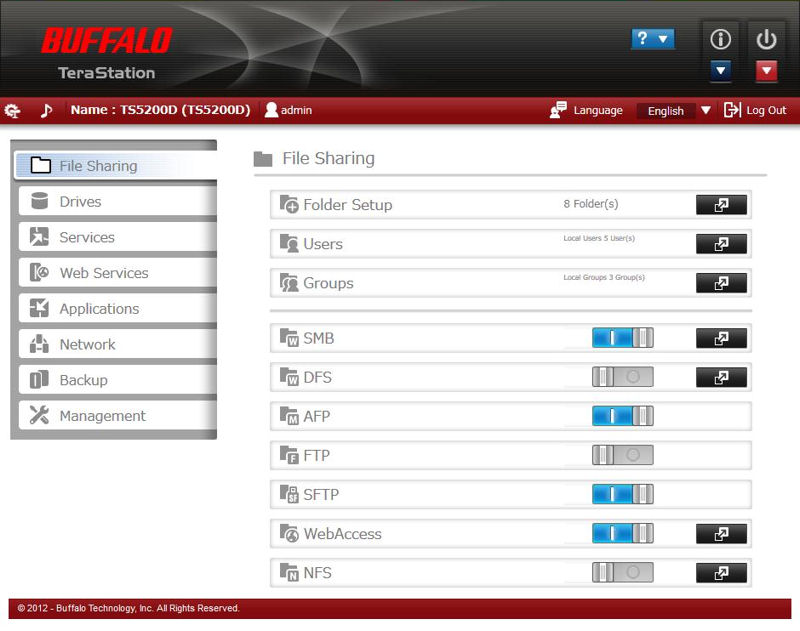
TeraStation advanced admin landing page
Performance
The TS3400 was tested with its factory-installed 1.01-0.20 firmware using our standard NAS test process to run tests with RAID 0, 5, and 10 volumes on four drives.
The benchmark summary below shows that the fastest Windows File Copy performance was achieved with the volumes configured for RAID 0 or RAID 5. However, the results were very lopsided with RAID 0 read performance of 105 MB/s far outstripping write performance of 67 MB/s and RAID 5 with 104 MB/s read and 58 MB/s write.
Poorest file copy performance was turned in by the RAID 10 configuration with read speed dropping below 100 MB/s (97 MB/s). Write performance, however, was almost at a par with RAID 0 write performance and was about 12.7% better than the RAID 5 write speed.
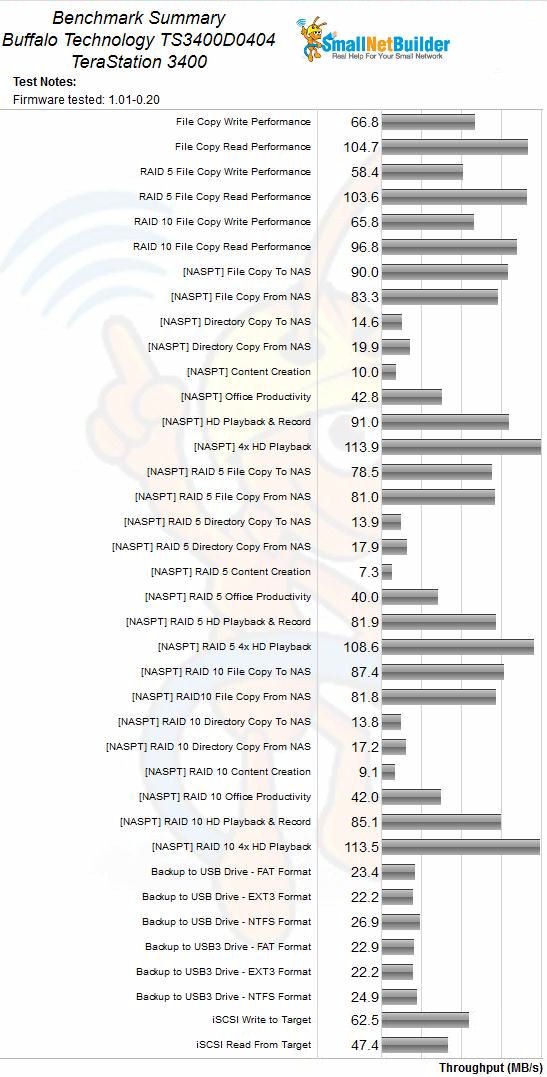
Buffalo TeraStation 3400 benchmark summary
As we’ve seen from other reviews, the Intel NASPT File Copy results are usually quite different from the Windows file copy results. Often, write performance is better than read performance. This was the case for the TS3400 except for RAID 5 where read performance slightly exceeded write performance. For the TS3400, the highest read rate was 83 MB/s in RAID 0; the highest write rate was 90 MB/s, also in RAID 0. But you’ll note that the NASPT file copy tests yields results that are less lopsided than the Windows file copy tests.
iSCSI yielded some interesting test results. iSCSI write came in at 63 MB/s and 47 MB/s read. That compares favorably with the 35 MB/s write and 45 MB/s read results turned in by the TS5200. The TS3400’s iSCSI write almost matched the TS5800’s write speed of 63 MB/s, but fell short of the TS5800’s 68 MB/s read speeds.
Attached backup tests produced best backup throughput of 27 MB/s was obtained backing up to an NTFS-formatted USB 2.0 connected drive. Interestingly, backup using USB 3.0 and NTFS yielded a slightly lower result of 25 MB/s. However, the range of performance was quite small with the lowest being 22 MB/s for EXT3 formatted drives for both USB and USB 3.0. Unfortunately, the drive formatter doesn’t support NTFS, so if you want to use NTFS, you’ll have to format your external drives before attaching them to the TS3400.
Ranking
Starting with this review, we have switched to classless ranking for NASes. Below is the Ranker Performance summary for the TS3400. Note that this ranking is for all products tested and doesn’t relate to a particular class of processor or number of drives. In this chart, undoubtedly the total ranking of #28 was dragged down by relatively low scores for iSCSI performance as well as Mixed Read Write scores.
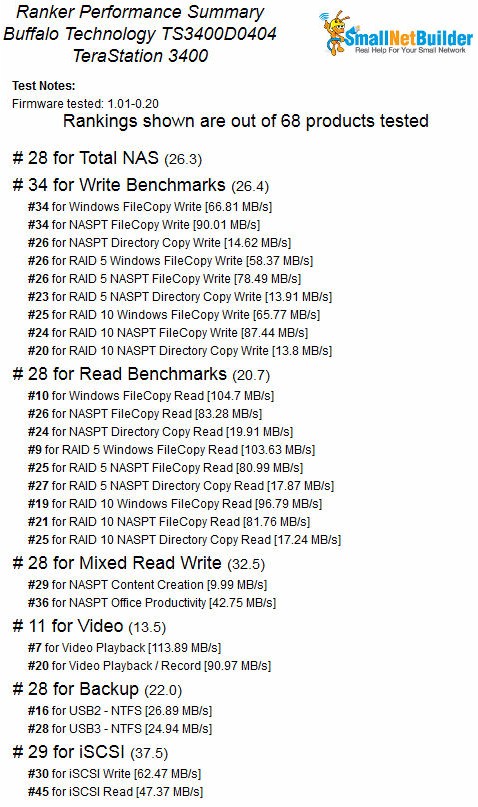
Buffalo TeraStation TS3400 NAS ranker performance summary
However, you can filter the NAS Ranker by the number of drives and the processor class. Filtering for four-drive NASes shows the TS3400 ranking 10 out of 18 products. All but two of the products ranked above the Buffalo are Intel Atom based except for the Intel i5-based iXsystems Mini Plus FreeNAS and, more significantly, Synology’s DS413, which is powered by a dual-core Freescale QorIQ CPU.
To see how the Buffalo ranked with other four-bay NASes using dual-core application-specific processors, I added an SoC-2 Class filter to the four drive filter and came up with the view below. You can see that there are only three products that now match.
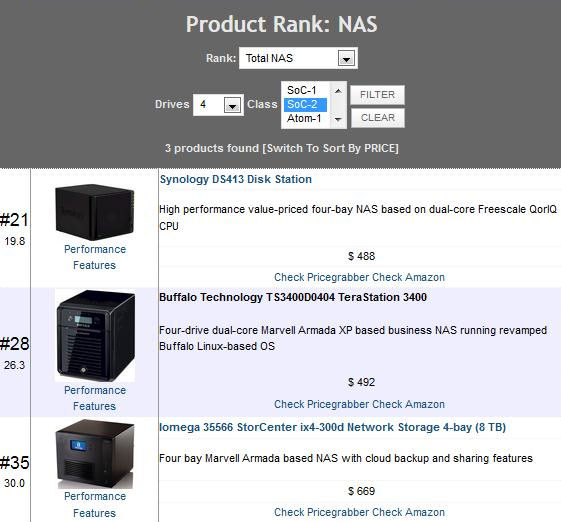
NAS Ranker results filtered
For this filter, the TS3400 ranks second behind the Synology DS413. But if you delve a little deeper, you’ll see that the TS3400 is a clear value winner in this matchup. A recent check of Amazon showed that the DS413 was selling for $499. The TS3400 was selling for $554. The big difference in value is the TS3400 price includes four 1 TB drives – the DS413 price is for a diskless 4 bay NAS.
Closing Thoughts
The TS3400 is another example of Buffalo’s focus in feature and performance improvement in its latest round of NASes. Unlike some of the earlier versions of TeraStations, the TS3400 has hot-swappable drives. It also supports RAID migration and RAID expansion. Rebuild times for a 4TB X 1 are reasonable, coming in at 8h 50m for RAID 5 and 7h 45m for RAID 10. There is full support for AFP, SMB, NFS and FTP. It can be used as a Time Machine target, or can be configured as an iSCSI target.
In reviewing Buffalo NASes, we’ve found that they generally don’t deliver best-of-class performance. And compared to products from Synology, QNAP and others, they lack some features, most notably any sort of app or add-in system.
But where they excel is at value and the TS3400 is no exception. The TS3400 is one of the most cost-effective four-bay NASes available, delivering a lot of storage and decent performance for your dollar.
